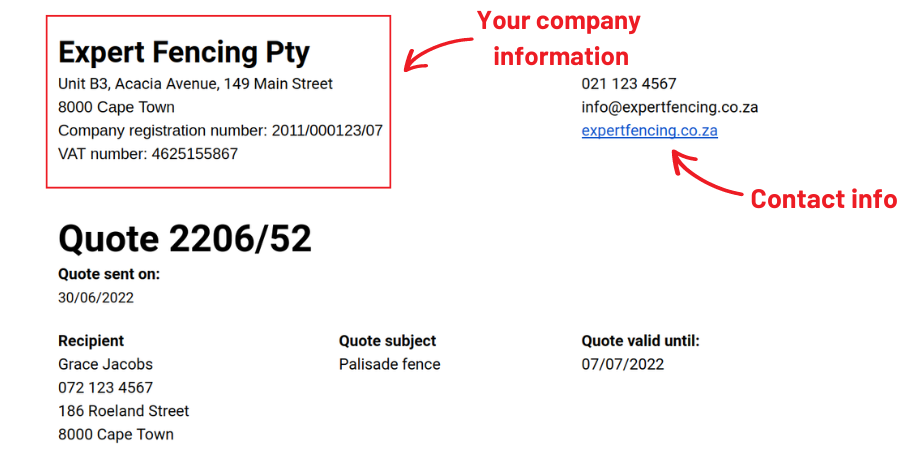You spent a lot of time and money to attract a potential client. You have finally received a request for your services. What now?
A job is within reach, and a good quote will help you close the deal. You need to act fast. But you also need to be detailed and accurate.

Download our free quote template and follow the guidelines.
What is a quote?
A quote is a fixed price for a product or a service you send to a prospect, interested in doing business with you.
A quote lays out exactly what you’ll do, and how much you’ll charge for doing it.
A quote’s objective is to persuade a potential customer to choose your offer over others.
The quoted price can’t be changed once the client accepts it.
What should I include in a quote?
You should send a quote in writing and include the following:
- Standard business information: Your company name and address, the client's details, and a quote number.
- Pricing: The final price with a breakdown of steps and all the costs involved. Keep this structured and transparent, but not so detailed that the customer loses interest.
- Taxes: Any applicable taxes, like value-added tax (VAT).
- Due dates: Project timetable and a completion date.
- A "valid until" date: Most quotes are valid for one month, but you can add any date you are comfortable with.
- Your terms and conditions: When this quote stops being valid, and when it needs to be changed.
- Payment terms: Do you require payment upfront? Or can the client pay in instalments? Do you accept credit cards?
How to write a quote?
1. Research the customer's needs
You have to communicate with the potential client before making an offer. Look at the request you received.

On Procompare you will find the requests with all the necessary information inside your user profile.
Call the customer and ask them to clarify the specifics of the job.
The best way to quote is after making measurements on-site. The next best way is to help yourself with pics and info you received through email or WhatsApp.
Note down everything you agree on, and everything that has yet to be resolved.
2. Use a quote template
If you have to write a quote, it means you are dealing with a hot lead (all the leads on Procompare are hot and need immediate response). You have no time to lose.
Always write the quote down.
Customers will have an easier time understanding the written quote, and you’ll have proof of what you agreed on.
Having a digital, easily repeatable quote template you can email will speed up your quoting process significantly.
All the information about your company, like the logo, address, bank accounts, and contacts, can be already pre-written on the template.

Click on the button below to download your own template. You'll need to be signed in your Google Docs account. Click the "Use template" button in the upper right corner when the document opens and enter your own data.
Get a free quote template3. Outline the works and fill in client details
Add the customer information: their name, address, and contact information. Enter the quote number and the date of issue.
Break down the costs of a job into line items. Take your time and think methodically through the job step by step.
Include a brief description of each service, units of material, and the price per item. Make sure you calculate your costs right and include the desired margin.
You don’t need to include every little step or minor supply, but a client must understand what they are getting for the set price.
Which is more convincing?
“Palisade fence R14,000” or “10 square metres of wood = R9,000. Posts, rails, nails and screws = R2,800. Staking out the location, digging post holes, setting posts into concrete, placing rails between posts, cutting and attaching panels, adding post caps, staining and finishing = R2,200. The final price is R14,000.”
An itemized quote will jump out when the client compares your offering with others.

Be transparent: Mention what’s not included in the price. If you charge a fee for fencing area preparation or waste removal, include that in the quote as a separate option.
Insert the completion date: Explain when will you start working and when each phase of the project will be finished. A range (“2-3 weeks to finish”) is better than nothing.
4. Name your price
The lower your price, the more appealing your quote. But be careful not to undervalue your services, or overestimate your ability to provide them.
Don’t commit to a low price just to get the business. You’ll lose time and money, along with the trust and respect of your customers.
Price your bid realistically. Do your homework on pricing your services right.
Once you've submitted your quote and your customer accepts it, it becomes a binding contract.
Focus on the benefits that you can provide. Explain to people that differences in quotes also mean differences in quality. Ultimately, you get what you pay for.

If people can see the value in hiring you, they’ll be willing to pay the price, even if it is more than your competitors charge.
Include VAT and other taxes in the quote.
5. Specify terms and conditions
Lay out the responsibilities of both you and your client to avoid future disputes.
- Disclaimers: Cite the conditions that might delay or alter the terms of the delivery. Let’s say you rely on the weather to get the fencing project done. If it’s raining on the day of the beginning of the project, you’ll have to delay work.
- Additional work and costs: Insert costs and charges for additional work beyond what is listed in the line items. This is in case the job becomes more complicated because of unforeseen circumstances or a client changes what they want.
- Payment terms: Specify when and how you want to get paid. Define whether you require a deposit upfront, in instalments and the payment methods you accept (cash, check or credit card).

6. Put in the validity date (and other calls to action)
Cost of supplies, demand for your services, and your availability change — so should your prices.
Give your quote an expiry date. It’s usually within 30 days. If the prices in your line of business can change in a week or even day to day, your quote’s validity should reflect that.
Another reason for setting shorter validity is to get the customer's response as soon as possible.
Send your quotes within one working day of receiving a quote request.
Emphasize the benefits of an immediate response. Besides a limited-time offer, there are other ways for you to instil FOMO in your customers, like lower prices for long-term collaboration, package deals, guarantees, discounts and other benefits.
Here's an example of what a quote ready for sending looks like, after you enter all the information into the template.

If you decide to offer a discount, you have to understand your profit margins so that you are not making a loss.
Make sure you are getting something in return: a larger project, long-term customer, prepayment, referrals or reviews.
Standardize your discounts. Don’t negotiate without a plan. For example, you could offer a 10 percent discount for prepayments in cash. Otherwise, customers will be angry at you when they find out you’re charging them differently than others.
7. Get a written confirmation, follow up if you don't
After sending the quote out, you should leave the recipient some time to read it through and decide if they want to go ahead with it.
Make sure you get a written confirmation from a client that they accept the quote.
Send a quote via email, then follow up with a phone call after a day or two to check if it arrived and what their decision is.

Customers will likely be getting multiple quotes. If you haven’t received a reply after a while, contact them again.
If your quote is rejected, ask why this was the case. Was your price too high, or was something else missing?
Ask questions! Use that knowledge to improve your sales and quoting.
Quotes are just one part of customer communication. You cannot expect every quote to be the winning one. A good process and a template will make quoting faster and easier for you. The better your quoting process, the more likely you will be to turn leads into clients in the long run.



